See you later, from the Why We Post team
By Daniel Miller, on 28 April 2017
This is our end-of-project blogpost, after five years of our ERC-funded project Why We Post. So, what has been achieved?
1) In the light of a comparative study of nine fieldsites and our eleven books of evidence, we hope people will fully appreciate that social media is always content, and content is always the local product of local social and cultural forces. The approach that extrapolates from an experiment to make claims regarding a generalisable thing called ‘social media’, does not work.
2) We have created a new digital ecology of research dissemination for effective global education. Our initial Open Access books have already achieved 183,000 downloads including 2406 in the Philippines, 1395 in Ethiopia and 1147 in Pakistan. We have taught more than 14,000 on our MOOC. Our combination of accessible writing, short videos, social media and storytelling is what makes this global reach possible. We are also adapting our material for use in schools. Our books are currently being translated into Chinese, Hindi, Italian, Russian, Portuguese, Spanish and Tamil.

3) We have shown that anthropology can be the very best method for exploring this most dynamic contemporary phenomenon. Long-term ethnography and participant observation enables researchers to build deep relationships with the people they study, providing access to intimate areas of life such as private spheres of social media, understood in the full context of offline life.

4) We have developed theoretical ideas and original insights for understanding social media, including ‘Scalable Sociality’ as a new definition of social media. By this we mean that social media provides greater control in communication over both the degree of privacy and size of group, when compared with previous forms of communications media. We have applied the theory of Polymedia, which describes how media choice has become more of a social and moral issue instead of one of cost and access. Finally, we have extended our understanding of what it means to be human with the Theory of Attainment, which includes all the things we have the capacity to be in the future. So a new technology such as social media simply allows us to attain something of that capacity, which was already latent in merely being human.
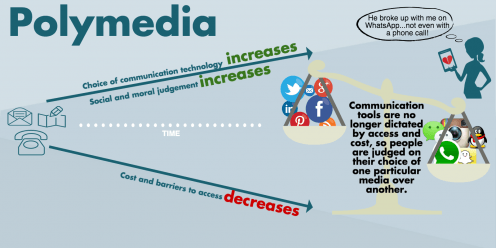
5) We have tried to bring balance to debates that reduce analysis of social media to whether it is a ‘good’ or ‘bad’ thing by showing how developments are almost invariably contradictory, such as being both good and bad for education, or representing movement towards and away from individualism. You can explore our discoveries on our website and see exactly how our cross-cultural scholarship make those contradictions clear.
Finally, thank you to everyone who has followed the progress of this project via this blog. We have appreciated your questions, challenges, and support. If you have not yet taken our free online course, the next run starts 12th June. Do sign up – we look forward to discussing the uses and consequences of social media with you there!
NOTE the Why We Post website will remain and in addition we will publish occasional announcements of developments on this blog. Several of us will be involved in a new five year project starting in September 2017 on Smartphones, Smart Ageing and mHealth which will have an associated blog.
Talking to the BBC about social media in China
By Tom McDonald, on 14 March 2017
Earlier this month, I was very fortunate to be interviewed by the BBC on my research onto the use of technology in China. The article that was published as a result of the interview is a good example of ‘public anthropology’, showing how the discipline’s research can made relevant to a wider audience.
This commitment to engaging with the public through anthropology is something that is also mirrored in two books that I published last year: Social Media in Rural China and How the World Changed Social Media (the latter is co-authored with the rest of the Why We Post team). Both of these volumes tried to respond to the immense interest in social media from the general public, by writing in an accessible and open style. We chose to keep all citations and the discussion of wider academic issues to endnotes. Many readers seem to have enjoyed this style of easy-to-understand writing.

Photo: Gillian Bolsover
A central aim of the book Social Media in Rural China was to try and help non-Chinese audiences, who have limited experience of Chinese social media and find it hard to imagine what they are like, to understand the nature of these platforms and the kind of social effects they are bringing to a small rural community in China.
Given this, it’s also been surprising to see how the book has been received in Hong Kong and Mainland China. I’ve gained a lot from discussing sections of the book with undergraduate and postgraduate students—most of whom are Chinese—in my Local Cultures, Global Markets and New Media and Digital Culture courses. Readers are often interested to understand a “foreigner’s” reflections on contemporary rural China.
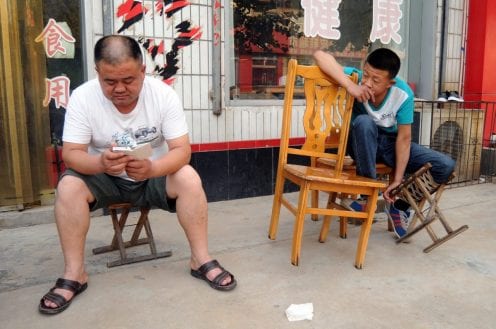
Photo: Gillian Bolsover
This feedback will be particularly useful as I put together articles for academic journals over the coming months. In this way, I am extremely fortunate to have the opportunity to balance two quite different forms of writing: academic writing aimed at fellow researchers in universities, and a more accessible writing for a general public which can also inspire articles such as the one that appeared on the BBC.
Visualising Facebook by Daniel Miller and Jolynna Sinanan
By Daniel Miller, on 7 March 2017
Today marks the publication of a new book called Visualising Facebook, which I have written with Dr Jolynna Sinanan. It is available as a free download from UCL Press and also for purchase in physical form. One of the key arguments from the larger Why We Post project, of which this book is one out of eleven volumes, is that human communication has fundamentally changed. Where previously it consisted almost entirely of either oral or textual forms, today, thanks to social media, it is equally visual. Think literally of Snapchat. So, it is a pity that when you look at the journals and most of the books about social media, they often contain either no, or precious few, actual visual illustrations from social media itself. One of the joys of digital publication is that it is possible to reproduce hundreds of images. So, our book is stuffed to the gills with photographs and memes taken directly from Facebook, which is, after all, our evidence.
For example, as academics, we might suggest that the way women respond to becoming new mothers in Trinidad, is entirely different from what you would find in England. In the book, we can reproduce examples from hundreds of cases, where it is apparent that when an English woman becomes a mother she, in effect, replaces herself on Facebook with images of her new infant. Indeed, these often become her own profile picture for quite some time. By contrast, one can see postings by new mothers in Trinidad, where they are clearly trying to show that they still look young and sexy or glamorous, precisely because they do not want people to feel that these attributes have been lost, merely because they are now new mothers.
In writing this book we examined over 20,000 images. These provide the evidence for many generalisations, such as that Trinidadians seem to care a good deal about what they are wearing when they post images of themselves on Facebook. While, by and large, English people do not. But this becomes much clearer when you can see the actual images themselves. Or we might suggest that English people are given to self-deprecating humour, while Trinidadians are not. Or that in England gender may create a highly repetitive association between males and generic beer, as against women with generic wine. In every case, you can now see exactly what we mean. We also have a long discussion about the importance of memes and why we call them `the moral police of the Internet’. How memes help to establish what people regard as good and bad values. This makes much more sense when you are examining typical memes with that question in your head.
To conclude, given the sheer proportion of social media posting that now consists of visual images, it would seem a real pity to look this gift horse in the mouth. Firstly, it has now become really quite simple to look at tens of thousands of such images in order to come to scholarly conclusions. But equally, it is now much easier to also include hundreds of such images in your publications to help readers have a much better sense of what exactly those conclusions mean and whether they agree with them.
This post was originally published on the #NSMNSS blog here.
“The Value of Social Media” at the AAA conference
By ucsanha, on 10 December 2016

Daniel Miller talking at the AAA conference. Photo by Nell Haynes.
From the Why We Post Team, Nell Haynes, Tom McDonald, and Daniel Miller attended the American Anthropological Association conference in snowy Minneapolis, Minnesota, USA at the end of November. All participated in a session organized by Heather Horst, and Robert Foster, titled “The Value of Social Media.” The session explored the use and meaning of social media through anthropological conceptions of value, which have advanced our understanding of practices that are meaningful to people and the worlds they inhabit.
Danny began the session with his talk on how social media may be used to create anthropological value. He related his ideas to those of Nancy Munn’s early anthropological research on the Trobriand Islands in which she suggested that social relations expanded an individual’s or group’s status, while something like witchcraft shrinks it. Indeed, the idea of anthropology is to expand knowledge, but there exist “witches” that work in contrast. He suggested these witches include obfuscating language, the tendency of anthropologists to be very individually focused, and the idea of criticism and critique without regard for actual solutions. But, he suggested that social media is a key way in which anthropologists might find value in their work. Both as a topic and as a medium for reaching wide student audiences, social media may actually demonstrate that anthropology helps us to understand the contemporary world, as well as become the means through which students from across the world can connect to other students, engage in discussions about anthropology, on platforms like FutureLearn and UCLeXtend, where the Why We Post Project’s online courses are based.
Nell Haynes used her fieldwork in Northern Chile to explore ideas of value that are not necessarily based in economics and currency. Looking at adult women who sell used clothing and home items through Facebook pages, Nell explained that the motivation for these women was not increased income, but social connections with other women that they create through their commercial activity. In essence, social media has opened not only new spaces for economic activity, but has given opportunities to women whose social worlds were once more confined to the family. For these older women, the “value” of their economic pursuits on social media do not correspond to the exchange value of the goods they sell, but rather the value of the social relationships gained, sustained, and strengthened through selling.

Tom McDonald talking at the AAA conference. Photo by Nell Haynes.
Tom presented on his research in Rural China, examining how hierarchies become overtly expressed on China’s most popular social media platform – QQ – in the form of level status conferred upon users through collecting points and virtual currency. He discussed the changing attitude of rural Chinese townsfolk towards these levels, showing how desires to accumulate levels influence their practices of internet use in everyday life, giving a cultural explanation for the appeal of these systems. In fact, users’ accounts of level accumulation cross between emphasizing honest effort and intentional distortion, and in so doing place value on the practice’s aspect of self-cultivation. Tom argued that individual internet users are able to transform social media use from a wasteful habit that incurs the disapproval of other family members into a virtuous activity.
The session was well-attended and inspired rousing discussion about a topics ranging from the role of critique in anthropology, to the ways that algorithms may influence social media users. Later in the day, with an equally exciting crowd, Danny presented on the project as a whole and the ways in which the anthropology of social media contributes to broader understandings of the discipline as well as understanding what it means to be human. In his talk, the keynote address for DANG or the Digital ANthropology Group of AAA, he focused on the “theory of attainment,” which posits that rather than suggesting, with each technological advancement we decry “the end of humanity” or entering a “post-human state,” instead what we define as human must take technological advancement into account. As such a definition of humanity takes into consideration human’s persistent ability to attain new advancement.
Overall, it was a productive and informative conference. Tom, Nell, and Danny only wished that more of the team could have been there with them.
From Facebook to ‘fakebook’ – who controls the information on social media?
By Xin Yuan Wang, on 24 November 2016

A young Chinese factory worker reading on his smartphone.
Mark Zuckerberg finally said that Facebook plans to have a more effective control of misinformation, which is a sharp reversal in tone from the comment he made immediately after the US election that the “the idea that fake news on Facebook…influenced the election in any way is a pretty crazy idea.” The fake news that circulated widely on Facebook is believed to have influenced the US election. It is reported that some fake news was created by teenagers in Macedonia who cashed in by catering fake news to demand, and many more were posted by ‘alt-right’ people who cooked up stories on platforms such as 8chan, 4chan, and social media.
The story of how fake news circulated on Facebook reminds me of what I have witnessed about the information consumption on social media among Chinese factory workers during my 15 months of field work in a small factory town in southeast China. Certainly, in many ways the two cases are incomparable, whereas the pattern of information dissemination seems to bear certain similarities.
For Chinese factory workers whose average education level is below middle school (most of them dropped out of school before the age of 17), social media has become the most important, if not the only, information resource. Therefore, social media actually plays an extremely important role in those less-educated people’s communication and (informal) education. What are the consequences of people being dependent on social media as their major information resource? Well, first of all, there will be a higher chance that the information people get will become unbalanced. For people who simultaneously consume news from other traditional media with ‘gatekeepers’, such as TV, newspapers, and magazines, social media is only one of the tools to get news. Therefore, even if there are fake news stories on social media, the reliability of that news will be constantly tested in a more rounded information environment and any possible hazard of fake news will be diluted in a more balanced ‘informational ecology’ – just like natural purification. However, if social media has become the only or the major information resource, the risk of fake news can be amplified. Generally speaking, the higher education people receive, the lower the chance that social media will become their only or major information resource.
To add another layer to the problem. Unlike traditional media where information is distributed in a relatively neutral way, information on social media is not only filtered by customised algorithms based on users’ personal information, but is also filtered by people’s personal social network online – that is to say, each social media contact is a potential news agent who feeds you news on a daily basis. To give an example, as written in the book Social Media in Industrial China based on my research, a comparison of the shared postings on 145 social media profiles of factory workers and 55 profiles of middle-class Chinese in Shanghai shows that there is almost no information flow between two different social groups. Over a period of four months only one out of 6,000 articles (0.03 per cent) was found to have been shared in both groups, though 5.1 per cent of articles were shared within the factory workers group and 1.6 per cent within the Shanghai group. In the case of factory workers, the possibility of the same information being shared within the social group with similar social-economic status is 170 times higher than the possibility of it being shared across groups with different socio-economic statuses.
Also, the amount of fake news I encountered on factory workers’ social media profiles was much more than that on the profiles of middle-class Chinese. Most of the fake news were sensational and dramatic stories about conspiracy, romance, or crime. Even though a few factory workers commented that they could imagine that there were certain ‘untruth’ elements in those news items, most people who shared the news believed the news was based on true stories and those who were not 100% sure certainly enjoyed the reading – as a kind of entertainment. “I would say there must be some truth in it (fake news) otherwise there won’t be so many people sharing it, right? Well, at least I feel for the story, that matters,” a 25-year-old male factory worker told me.
So while there is now the debate about how a social media company can take responsibility to control fake news on social media, for all intents and purposes one also has to acknowledge that in many cases, the most powerful information control comes from people’s sociality – on social media there is a certain truism: ‘who you know may decide what you know’. Among like-minded friends, on social media one receives news that is in most cases only confirming the beliefs shared by the social group one belongs to.
Public anthropology: urgent yet undervalued
By Laura Haapio-Kirk, on 17 November 2016

An education in anthropology encourages us to look beyond cultural assumptions.
In the days following the results of the US presidential election, there has allegedly been a wave of racist attacks and hate crime across the States against Muslims, hispanic Americans, black people, ethnic minorities, and the LGBT community. At the root of such behaviour is deep cultural ignorance and education is one of the most powerful weapons we have against intolerance and fear of the ‘other’. The humanistic sensibilities that an education in anthropology fosters can be paradigm-changing. It seems apparent that a commitment to an engaged public anthropology has never mattered more, or been more feasible in this digitally connected age. Many anthropologists, including the Why We Post team, feel the moral and political imperative to bring anthropology to a wider audience than was previously possible with traditional modes of research dissemination. But as anthropologists situated within today’s hyper-competitive academic job market, how can we navigate the often tenuous balance between public and academic output?
How can we manage to produce high-quality public content at the same time as managing the responsibilities that come with being professional anthropologists working within the demands of the academic job market? This was a question put to me by Alisse Waterston, the president of the American Anthropological Association, after a talk I gave at the IUAES in Dubrovnik back in May. The theme of IUAES this year was ‘world anthropologies and privatisation of knowledge: engaging anthropology in public’, yet my panel was the only one with the explicit theme of how to bring anthropology to the public. The panel convenors, Jenny Ingridsdotter and Kim Kallenberg from Södertörn University in Sweden, explained the difficult balancing act inherent in their academic lives: “In order to pursue an academic career we are encouraged to write peer reviewed articles and engage with research communities. Yet little time is left to engage socially and interactively with local communities or communicate important results to public spheres. As young scholars it might be even more complicated to legitimise designation of time to public output. Still we feel it is really important and at the core at what we do as ethnographers.”

The Why We Post course on FutureLearn runs three times per year.
I believe that there are several factors that enabled our team to successfully produce large amounts of public output at the same time as writing up their research, publishing, and applying for jobs (all of the 5 post docs have now secured academic employment). Firstly I think it’s important that public engagement shouldn’t be an afterthought to research, but like with Why We Post, should begin from a project’s inception if it is to be successful. Partly this is because the writing skills necessary for communicating to a general public take time to hone, and also because it’s important for researchers to understand early on in their work the kind of field material (video, photographic, textual) they need to record in order to produce engaging content that will appeal to non-anthropologists.
Given our topic of research is the uses and consequences of social media, our project was conceived as having a broad appeal from the outset; with selfies and memes we might be able to bring people to anthropology who otherwise might overlook it. Project leader Daniel Miller envisaged a spectrum of dissemination/engagement methods including open access books, an e-course, and a public-facing website, all of which was made possible by a generous ERC advanced grant which funded the project and has covered my salary as a public engagement fellow and research assistant. I was hired at the three-and-a-half-year mark when the team were in the process of writing up. Working with these talented researchers to produce our public content I saw how it was often difficult for them to juggle the academic and public output, even with the support of a team. The more conversations I had with them, the clearer it became: public engagement in anthropology is currently institutionally undervalued and needs greater recognition within the established modes of evaluation that researchers are subject to. I think that projects with more limited resources than ours would struggle to produce the same range of public output, despite the best intentions of individual researchers to reach beyond the ivory tower.

Can we draw people to anthropology through analysis of popular culture such as the selfie?
In addition to writing 11 open access books (aimed at both academics and lay readers, with jargon-free text and references kept to footnotes), the Why We Post team agree that producing visual and textual material for the online course was the most time-intensive of our initiatives, taking longer than expected. One of our researchers, Shriram Venkatraman believes that this was mainly down our high production values coupled with our lack of experience in creating such material – and a lack of existing models to follow. We were the first UCL course on FutureLearn and the first comparative anthropological online course of this scale. The sheer amount of material coming from our project also posed a challenge – how do you condense insights from a total of 135 months of ethnographic fieldwork across nine fieldsites into a concise course aimed at a general audience? The answer: a combination of Googledocs, tracked edits, miles of emails, and a lot of good will and humour. Support also came from UCL’s Digital Education team whose expertise in online learning was pivotal in developing a successful course.
Despite the time-intensive nature of scripting and filming course content, Jolynna Sinanan commented that the skills she gained were invaluable: “The time pressure was immense but the skills we learned in filming, writing, developing and translating content for the course were very valuable, especially when gaining public exposure for our research is becoming more important. We are also competing within an academic climate that values producing a high level of quality as well as quantity, so we need to display virtuosity as well as accessibility with our research outputs, from being able to write journal articles to making short films for YouTube.” The skills developed in public engagement can also benefit traditional academic output, as Xinyuan Wang explained: “producing the course actually helped my academic writing as in the course I needed to describe and discuss things in a straightforward and engaging way (which is actually more difficult in many ways than composing an academic paper). After working on the course, my own arguments actually became clearer and better constructed, which is definitely very helpful in my future writing and actually saved time rather than wasted time in the long-run.”
While the process of transforming research findings into public education was both challenging and rewarding, once the team’s contracts were nearing completion and they launched into job searches they faced a new challenge: the academic job market currently does not value online learning in the same way as offline learning. Dr Nell Haynes, our team member who conducted her fieldwork in Northern Chile explained: “The online course is not at all considered to be equal to teaching in-person courses, despite the fact that it actually took much much more time, revision, and creative thinking than preparation for a traditional lecture course. And while there has for some time been a strong movement by anthropologists to have administrations grant more weight (in tenure review and other institutionalised forms of evaluation) to public work, it certainly seems that search committees are often reproducing these very biases. Based on conversations with other job applicants this does seem to be a systemic trend.”
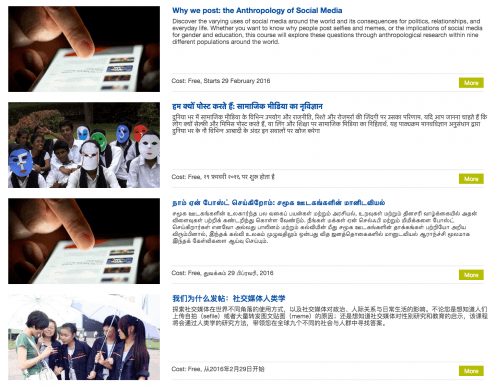
Our course is available in the 7 languages of our fieldsites on UCLeXtend.
If we as a discipline do not value public anthropology highly enough, is it any surprise that the public generally have little time for anthropology? How can it be that a discipline which claims to be global and encompassing in outlook is so limited in its output, often failing to give back to the very communities that it draws knowledge from? We decided to make our e-course and website (including 130 films) available in the seven languages of our fieldsites, and we are in the process of arranging translations of our open access books. The hope is that as public awareness of anthropology grows through such efforts, that there will be more demand for the discipline. As Shriram Venkatraman commented: “our effort is just the start of something big. When there is more recognition from within the field for public outreach and the social impact we can create, this will hopefully encourage many more such efforts which will increase the standing of Anthropology in the eyes of the general public.”
It is heartening to see other efforts towards quality and sustained public anthropology, such as the founding of the Public Anthropology Institute (PAI) at Wesleyan University, and we hope that such initiatives garner wide praise among anthropologists. We have a duty to promote the kind of cultural sensitivity that anthropologists take for granted to as broad an audience as possible, so that people who see cultural difference as a potential source of anxiety, might come to appreciate, and even delight in, the multitude of ways there are to be human.
Thanks to the Why We Post team for sharing their experiences of the public engagement balancing act. Also thanks to our lively panel at IUAES (Berna Yazici, Laura Korčulanin, Miha Poredoš, Aivita Putnina, Branko Banović, Margarita Barrera, Helleka Koppel, and Pascale Hancart Petitet) who continued conversations with me beyond the conference, and who are involved in projects ranging from public art installations of golden excrement in the ‘Give a Sh*t’ project, to an anthropological radio show in Laos.
Taking Why We Post to China
By Daniel Miller, on 11 October 2016
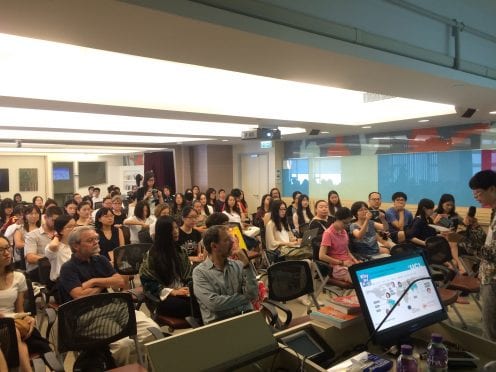
Although the Why We Post project is primarily an attempt to study the use and consequences of social media, there were other broader aims. Particularly, the hope that the project would show that while the discipline of anthropology might have originally developed for the study of tribal peoples or ethnic minorities, it is also the most effective means of understanding a global, contemporary and highly dynamic phenomenon such as social media. This would be an especially important message for the largest population of the world, China, where anthropology retains a rather conservative position within the university systems and there is a real chance that it will not survive let alone take its proper position as an effective and vanguard approach to the contemporary world.
As it happens, it is hard to think of two more effective means of making this point than our two books on social media in China. In particular, Tom McDonald’s study in rural China has a consistent narrative about how even such small rural towns are actually thoroughly imbued with digital transformations and tend to have better connectivity today than the village he comes from in Yorkshire. It is a still clearer point for Xinyuan Wang who effectively demolishes most stereotypes about Chinese society – for example the commitment to education and kin – by showing the distinctive nature of not some small exception, but the 250 million Chinese represented by her study of new factory workers. The comparison between these two books, Social Media in Rural China and Social Media in Industrial China, showcases the diversity of contemporary Chinese society and how can we better grasp the nuance and depth of a changing society through a contextualised understanding of the evolving nature of Chinese social media.

Daniel Miller at the People’s Press who are publishing Chinese versions of the books.
To share our findings we organised a trip to four major centres (Hong Kong, Guangzhou, Beijing, and Shanghai) and nine separate institutions. At a major anthropology and sociology department such as in Hong Kong University, Sun Ya-sen University in Guangzhou, and the Chinese Academy of Social Science in Beijing we could highlight our key point about this potential for anthropology itself in working with dynamic and shifting new media. But it was equally important to talk to Communication Departments such as at the Baptist University of Hong Kong, the Chinese University of HongKong, and the Communication University of China in Beijing so that students in that discipline were exposed to the potentials of ethnographic fieldwork. Our audiences ranged from arts and humanities at NYU in Shanghai, to philosophy students in Fudan University of Shanghai. We also visited the People’s Press who had published Xinyuan’s translation of the Digital Anthropology book and where I realised that my fellow authors included both the present and all the past presidents of China.
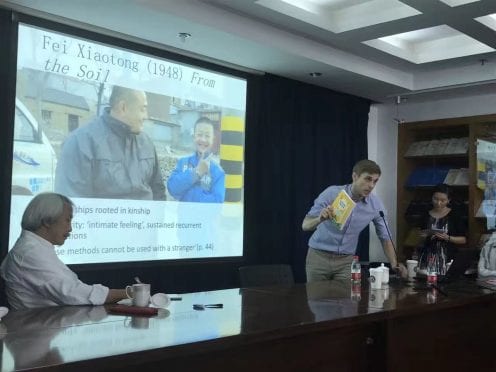
Tom McDonald delivers his talk on social media in rural China.
We carried out a live online book launch from Hong Kong (which you can watch again here) and opened an exhibition about the project at Hong Kong University where Tom now teaches. We also made sure that all the films on the Chinese version of our website were stored on UCL servers, rather than on YouTube which is blocked in China, so that students in mainland China could access them. Our trip attracted interest from Chinese local media including two of the largest Chinese online news agents, PengPai news and Tencent News, as well as the most popular English TV channel in Shanghai, Shanghai ICS, helping our message to reach more than ten thousand Chinese people within a few days.
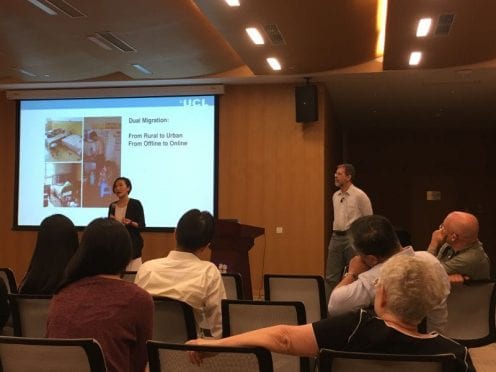
Xinyuan Wang explains the dual migration from rural to urban and from offline to online in industrial China.
On a more personal level there were two striking responses. One was the delight of audiences when they realised that Tom would be lecturing in Chinese which was important to convince them that he could be an effective fieldworker in China. The other was the way young female students were clearly inspired by the elegant and articulate but also poignant presentation by Xinyuan and they made clear that they didn’t just want to emulate our way of working, but saw her as a model for what women in China could become in the future.
Why We Post Tour of Chinese Universities
By Xin Yuan Wang, on 12 September 2016
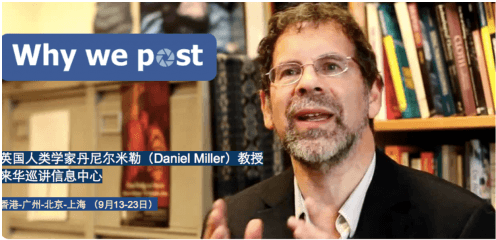
Between 12th-24th September 2016, Professor Daniel Miller and two researchers on the Why We Post project, Tom McDonald and Xinyuan Wang, will give a series of talks about the findings of the project at nine top universities in HongKong, Guangzhou, Beijing, and Shanghai. This China tour also include the launch (13th September) of the two newly released open-access books: Social Media in Industrial China (Wang, 2016) and Social Media in Rural China (McDonald, 2016). If you can’t be with us in Hong Kong, do join our live-streamed launch and put your questions to the authors.
China was the only country in the Why We Post project with two research sites. One of the reasons for this was because China maintains a greater degree of separation and autonomy in their use of popular digital media when compared to the rest of the world, therefore a global comparative study of social media required close scrutiny of particularly Chinese forms of social media such as QQ, WeChat, and Weibo.
The project includes a considerable amount of material on China such as the two newly released open-access books by UCL Press; one of the five weeks of the Anthropology of Social Media e-course; and a series of films set in the Chinese fieldsites. All of our short films (more than 100) about the uses of social media from our nine field sites have Chinese subtitles, and our website and e-course are both available in Chinese. Bringing an anthropological understanding of Chinese social media in the context of a comparative study back to China is a big commitment the project’s ultimate goal of turning global research into free global education.
Despite there being Chinese universities that teach anthropology, they have tended to see anthropology as a discipline that deals mainly with minority populations. We believe that the more a population becomes modern and urban and indeed digital, the more we need anthropology. This is because most of life now happens in the private sphere. In a little village perhaps it’s easier to see what’s going on from a surface glance. In a modern city where everyone goes to their own private home after work it is much more difficult. So you need research that is not afraid to follow people into the places where they actually live, which may be inside their smartphones, their social media profiles, as well as inside their homes. Otherwise we will not understand the modern world at all. Asking people questions via superficial surveys is not enough. Anthropologists spend many months living with people in order to be sure they understand what is really going on.
We believe that digital technologies including social media may be more formative of life in China than in almost any other country. While China has great and honourable traditions, the development of what we think of as modern China is relatively recent and relatively fast, taking place at the exact same time that new digital technologies are becoming an integral part of people’s lives. So whether we’re talking about the infrastructure of new cities or the spread of inexpensive smartphones, digital technologies are ubiquitous to the new China, and this means it is particularly important to understand their use and their consequences from a deep and engaged anthropological approach.
We hope that this China tour will introduce digital anthropology as a research tool to the Chinese academy. It is also hoped that the debates and talks will help to formulate key questions for future study within Chinese anthropology. We hope that China will play a key role in these future studies commensurate with its importance as a modern population that is embracing every form of new digital technology, and hopefully also embracing anthropology as the best means for observing and understanding their consequences.
The table below contains details of the talks in this China tour. For further updated information (in Chinese) please see here: http://uclwhywepost.isitestar.vip

巡回演讲安排 Brief Schedule of the China Tour
Emergent Brazilians comment the impeachment of the president
By Juliano Andrade Spyer, on 2 September 2016

This is one of the memes circulating among low income Brazilians in reference to the impeachment of President Dilma. The top comment says: “Gosh, is this true?” Below the image it reads: “‘I do not recognise the new Brazilian government’, says Obama, threatening to close the American embassy…
One of the latest hot topics of research in Brazilian social sciences is the extreme polarisation of opinions in the country. Social media was at the centre of the street protests of June 2013. The impression then that the internet was unityfing Brazilians against corrupt politicians. However, only a few months later online communication apparently helped to intensify tensions between groups in society. In my (educated middle class) circle, for example, almost everyone (if not everyone) has experienced “unfriending” or being “unfriended” on Facebook because of different political views. (If you are not following the news about the political crisis in Brazil, read about it here.)
But I wonder how lower income Brazilians were perceiving the same events and how they viewed the Senate’s decision to impeach the president. Thanks to WhatsApp, it was easy to contact them and quickly get some answers, which I translated and added below. Similarly to the educated middle class, these emergent Brazilians are also following closely this debate, partially because of the television coverage, but also independently via social media through the exchange of memes – see images at the top and at the end of the post. They are also divided in regards to supporting or not the Senate’s final decision, but three out of the four informants considered the impeachment unfair. More interestingly, though, is to note how the intensity of debates has enriched their understanding of government politics.
Opinion 1: “Fair? The condemnation did not have plausible arguments and just to have peace of conscience they did not take away her political rights”, which should be the legal outcome of an impeached president.
Opinion 2: “My son cannot take a test in his (public) school because they don’t have paper and the privately hired staff are 3 months without receiving salaries. I am against the government because of the matter of education. In the last few years my son has had only one or two classes per week. Both the governor and the mayor are from the Worker’s Party [same as the president], and they have been in charge for the past 12 years. I think the impeachment was unfair for the particular reason presented, but fair for the overall situation. I have many friends that are unemployed.”
Opinion 3: “In my opinion it was not fair because it was the people who elected her. To be honest, I wanted her to leave, but I would like to choose who would replace her. To some Brazilians like me, it is as if we have no voice and the only thing we can do is to wait for the country to fall to pieces, and we are the country. I feel sad because instead of advancing we are going backwards. Public education is weak, health services are worst and I do not need to comment about violence.”
Opinion 4: “I feel things will get worst. I am worried. The new government did not receive the votes from the people and they will govern wrongly. ‘We will have to pay the price in the future.’”
Below, some of the memes they are circulating.

It says: “In the Senate, Bahia is the only state that voted unanimously against the impeachment…”

It says: “In his speech, Temer [the new president] says he will not tolerate to be called a coup leader”.

It says: “Gleisi: Be strong, Dilma. She is facing the second coup of her life today.”

It says from top left: “Home of the mayor, home of the city councilmen, home of the secretary. HOME OF THE VOTERS.”
Memes that Brazilians are sharing about the Olympics
By Juliano Andrade Spyer, on 16 August 2016
One of the stars of the Olympic games in Rio has been the crowd itself. The liveliness of the crowd has attracted the attention of the foreign press (NYTimes, BBC), and particularly of athletes and their coaches. My personal favourite case has been how football fans yelled in chorus “zika” every time the US goalkeeper touched the ball during matches (learn why).
A lot could be said about Brazil and Brazilians based on these reactions so the point of the post is to show what low income Brazilians are sharing on social media in relation to the Olympics. This type of reaction can be considered as a form of long distance virtual cheering (or booing).
I will add the images below with translations and brief comments.

Sex is perhaps the subject I have written more often about in this blog so I guess it is not a coincidence that the image below is the meme I received more times from informants. The text at the bottom says: “Never complain again of when your sandals break.” (I added a patch to make it “decent” for all possible audiences, but I am sure the idea is clear.)

Violence and crime are also dealt with through humour. Above the title says: “ornamental assault”.

Above: “The violence is so great in Brazil that our first medal was on shooting.”

There are some criticism about the idealization of the country. Above, the Brazilian replies: “You should come live here, then.”

There is humour about Brazilians, as in the banner above made to persuade Brazilian players to give their best: “Play like we drink.” The slogan at the top says: “The best about Brazil are the Brazilians.”

And at last but not at least, there is football. Some commentators say that the problem with the Brazilian crowd is that they behave as football fans in every sport modality. And I guess if Brazil only won a gold medal in (men’s) football, every other outcome would seem OK. Unfortunately, this is unlikely to happen, as the meme above shows, referring to star player Neymar: “Football lesson”.
 Close
Close





